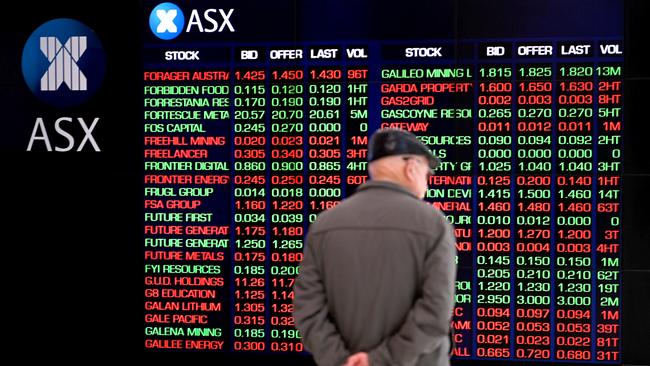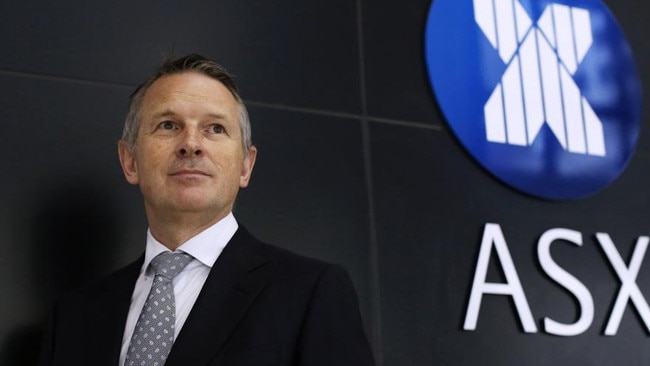Stalemate: How the ASX’s CHESS strategy came unstuck
A huge spike in trading volumes on the ASX on a Friday in the early days of the Covid pandemic set alarm bells ringing at the market operator, whose CHESS system was clearly struggling to cope.

Business
Don't miss out on the headlines from Business. Followed categories will be added to My News.
It was during the initial dark days of the Covid-19 outbreak in Australia that the ASX’s top team was thrust into the spotlight.
It was a Friday in March 2020, and the ASX’s daily trading volumes spiked to a record $18.1bn, reflecting about three times the daily average. In the days leading up to that Friday, share trading volumes had also been heavy.
It was unprecedented and investors were highly anxious. The spike in volumes was in response to the pandemic and its potential economic impact on the global economy, which had triggered wild swings in financial markets.
It was all hands on deck at the ASX from its highest echelons right down to its operations team, and by this stage the corporate regulator was firmly in the frame too. The ASX’s ageing CHESS – the Clearing House Electronic Sub-register System, the clearing and settlement system which underpins the efficient operation of the exchange – was unable to cope with the sheer volume of trades.
Thankfully it was a Friday. Had the volume spike occurred any other day of the week there was a real risk the local market wouldn’t have opened the following day, informed sources told The Weekend Australian.
It was over Saturday and Sunday that the ASX team would have to process the overspill of trading volumes, out of hours, after receiving the requisite information. Then ASX chief executive Dominic Stevens organised several executive committee meetings a day as the team scrambled over the weekend, and it wasn’t until late afternoon on the Sunday that the trades had all been cleared.
By this stage, the Australian Securities & Investments Commission had held an emergency phone call with the ASX, represented by then operating boss Tim Hogben, Chi-X and the nation’s nine largest brokers.
It was the sheer number of trades executed across the ASX and Chi-X – which swelled to about 7.1 million on Friday, eclipsing a daily average of about two million – that piqued the regulator’s interest.
An ASIC communique to brokers landed at 8pm on that Sunday imposing a legal requirement to restrict volumes by 25 per cent from Friday’s bumper levels. Stockbrokers were livid and several asked ASIC and Hogben who was going to compensate them for having to turn business away.
There was no time to lose, however, and stockbroking firms were required to confirm their participation in writing before the market’s open on Monday. It was a volatile and uncertain time.
Against this backdrop, ASX’s Stevens met with his executive team on the Monday to express relief they had navigated the tumultuous period. According to sources, Stevens turned to key lieutenant Peter Hiom and asked about how the upgraded CHESS – which would draw on distributed ledger or blockchain technology – would cope in a situation of elevated trading volumes.
The answer was telling, but not what Stevens had wanted to hear. The CHESS upgrade project was configured to facilitate the same amount of trades per second as the existing infrastructure and system, which had been around since 1994. Stevens is understood to have flown into a rage, telling the team to figure out a solution.
Hiom declined to comment, while Stevens didn’t return calls seeking comment. An ASX spokeswoman said: “In relation to matters relating to the previous CHESS replacement project, we’re unable to provide comment at this time given they relate to the current proceedings brought by ASIC.”

It was at this critical juncture in 2020 that several ASX insiders and market pundits believe the CHESS upgrade should have been shelved. Had the project been dismantled they estimate the ASX would have suffered a writedown in the order of $25m, which pales in comparison to the steep writedowns of $250m before tax announced in November 2022.
“Ego trumped the ability to say ‘we’ve stuffed up’,” said one former ASX insider, who was with the bourse during the period in question. “It was impossible to re-spec such a critical piece of the design.”
Another former ASX employee had a different view and said: “The specifications given to the vendor did have to materially increase (during Covid-19). The speed at which volumes increased was not an expected outcome.
“Dom (Stevens) genuinely wanted to get it (CHESS upgrade) done. His tenure was tied to it.”
Others have apportioned some blame to vendor Digital Asset Holdings, which they claim didn’t deliver the code required for the project and changed the original scope of work. Digital Asset was contacted for comment. In a submission to a parliamentary committee last year it said “specific functional requirements imposed by ASX … were incompatible with a contemporary, scalable system”.
The ASX had looked at markedly scaling the CHESS system, but the game had now changed. There were a lot of inputs that needed to be considered, only one of which was the number of transactions processed per second. How would the end of day processes work? What about if a stock was suspended?
This was critical market infrastructure.
On March 25, 2020 ASX announced it was undertaking “a replan of the CHESS replacement system” as it looked to accommodate the impact of the pandemic and functional changes requested by industry participants. There was a consultation period and the ASX flagged the go-live date for the new CHESS of April 2021 would be delayed. It was a sign of things to come as the project became riddled with delays.

The earliest phase of CHESS started to replace the manual settlement of trades in 1994 and two years later the system became fully operational. Fast forward to 2016, and a plan to replace the ageing CHESS platform was unveiled under then ASX CEO Elmer Funke-Kupper. That year, he told shareholders US company Digital Asset Holdings’ distributed ledger technology was no mere “replacement” of the clearing and settlement platform, but would instead be “innovative re-engineering”. ASX had partnered in 2016 with Digital Asset in a broad sense at this time and taken a small equity stake in the company. It wasn’t alone in backing the company; other early investors included Goldman Sachs and JPMorgan.
The plan of the ASX’s then boss was to see if the market operator could cut out the registries and other intermediaries in the market, instead offering a new technology that could run the gamut of trading.
Although the ASX did consider at the time launching into a direct replacement of CHESS with an off-the-shelf product from the likes of Nasdaq, the prevailing view was to try something different. But the proposal was risky. Sources said the initial architects of the CHESS replacement project had thought about keeping the attempt confined, giving it a few years to see if the proposal had merit and if not, pull the plug and opt for an easier option.
CHESS, which was written in Cobol, already an old coding language at the time of its introduction, sequentially processed trades as they came through, while the proposed Digital Asset scheme would have allowed for simultaneous and multiple transactions to pass through systems.
But just as the ASX was set to launch its CHESS replacement, having cleared a floor at its Bridge Street headquarters and begun building a team, Funke-Kupper was standing aside, as allegations from his time at Tabcorp were investigated. He was cleared of any wrongdoing in 2019.
Within months the ASX’s long-term chief information officer Tim Thurman also left. The Canadian who joined in 2012, left just three months after a damaging hardware failure.
In late 2017, Stevens was in the ASX’s top job and was telling reporters a blockchain-led clearing and settlement system would cut trading costs and put Australia “at the forefront of innovation in financial markets”. Digital Asset was formally engaged on the work.
The process of selling the message and getting stockbrokers and other participants on side began.

By 2021, a technology vendor – which was liaising with the ASX on the upgrade of the CHESS – provided ASIC with a detailed letter covering its concerns about the program. The vendor also had meetings with ASIC, the Reserve Bank and the prudential regulator to discuss its concerns about scalability and operability.
Hiom, a key sponsor of the CHESS replacement project who had also served as chair of Digital Asset for a period, left ASX in May 2021. That perhaps should have raised the alarm.
The pressure on the project was intensifying and later that year ASIC imposed additional licence conditions on ASX Ltd, ASX Clear and ASX Settlement, including a requirement for an independent expert to review the implementation program.
In early 2022, Stevens announced he would retire as ASX CEO and the search for a successor ramped up. All the while ASX investors and industry participants were being told the CHESS replacement program was on track.
FinClear managing director David Ferrall said the whole industry was “aggressively” building their technology to meet the needs of the CHESS replacement.
He said ASX statements, including one by a senior executive at an industry event in early 2022, weeks before the CHESS replacement was put on ice, suggested the program was on track.
“A senior executive stood up and said and reiterated what we had been told a year or two prior, that it was not a matter of if, it was just timing and the technology is working and operational,” he said.
“The industry had reservations. There were a lot of question marks around it.”
A stockbroking executive, speaking on the condition of anonymity, said he expressed reservations about the CHESS upgrade at a key meeting with ASX representatives. “The risks of the CHESS project were known and were being articulated to the ASX 18 months before,” he said.
Lofthouse took the reins as ASX CEO in August 2022, despite overseeing a period in the markets division that would later trigger a penalty of $1.05m following an ASIC investigation – the first time ASIC had issued an infringement notice to a market operator.
Not long after that fine in March this year came a much bigger hit by ASIC that would go to the heart of ASX’s position in the financial landscape: a landmark legal case against the ASX that alleges it misled investors over the status of the CHESS project.
ASIC alleges ASX market announcements in February 2022, saying the CHESS project remained “on-track for go-live” in April 2023 were misleading.
The botched CHESS upgrade was shelved late in 2022, triggering an inquiry by a parliamentary inquiry and various regulatory interventions.
More Coverage
Originally published as Stalemate: How the ASX’s CHESS strategy came unstuck



